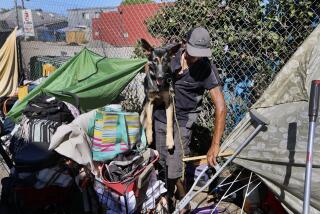No Place to Turn : Homeless Uprooted in Little Publicized Wilmington Cleanup
- Share via
WILMINGTON — There are no big canvas shelters here, no bright television lights and no well-organized advocacy groups lobbying city officials for help.
Twenty-five miles south of the widely publicized Tent City II in downtown Los Angeles, a homeless community at the edge of the Port of Los Angeles is quietly being run out of town.
Over the past several weeks, scores of homeless people have been forced to tear down their leaky shacks, fold their faded tents and move their dilapidated cars from lots in a run-down redevelopment area that the city of Los Angeles wants to turn into an industrial park.
Nowhere to Turn
And, unlike those who found temporary refuge in Tent City II--a shelter for the homeless that opened during the holidays--Wilmington’s uprooted have had nowhere to turn.
“We have had a drop of about 100 persons or more,” said Mike Larranaga, director of St. Joseph’s Table, a soup kitchen several blocks from the industrial area just south of downtown Wilmington. “We were feeding 220 to 225 on weekdays, but I now have days when there are only 97.”
Some of the displaced people have moved onto nearby unpaved streets, while others have taken refuge in junkyards and alleys. Many have left town, telling friends they hoped to find shelter in Long Beach or in downtown Los Angeles.
‘Tired of Moving’
“There is no place to stay without someone coming and sweeping you away,” said James Benskin, who has lived in a lean-to off Broad Street for about a month, but fears he soon may have to move again. “You get tired of moving. I’d hate to have to pick up and move again.”
While nobody knows for sure, city officials and local advocates for the homeless estimate that as many as 150 homeless people in the area have been uprooted from the industrial area since November, when several property owners began cleaning up their lots under pressure from the city.
The largest displacement occurred last week, when 80 to 100 people were forced to evacuate a three-acre lot owned by Southern Pacific Transportation, city officials said.
The city, in an effort to attract new businesses and jobs to the depressed area, has ordered the cleanup. Harbor-area Councilwoman Joan Milke Flores, whose office is behind the effort, has said the city must stop the illegal dumping of debris and rubbish before it can persuade new companies to locate in the area.
In letters from the Redevelopment Agency, the city warned about 300 property owners last fall that if they did not voluntarily clean up their lots, the city would clean them up--and put the bill on the owners’ property taxes.
With the city cleanup program expected to get under way as early as next month, several property owners have rushed to remove the tons of trash themselves. As a result, bulldozers, cleaning crews, no-trespassing signs and shiny chain-link fences have replaced mounds of garbage--and scores of makeshift homes.
“They want us out, and if they have to, they will stand us up against a wall and shoot us,” said Homer Gomez, who was forced to move his home--a 1971 Dodge Coronet--from the Southern Pacific property last week. Gomez, who said he became homeless six years ago when he lost his job as a steelworker in Vernon, moved his car across the street near a salvage yard.
‘Give Us a Place to Live’
“I don’t think nobody should have to live like this,” said Gladys Greer, who shares the Coronet with Gomez. “We are going to refuse to move anymore. Give us some houses. Give us a place to live.”
City officials acknowledge that the cleanup effort--if successful--will displace most of the area’s homeless.
“It is a very unhealthful situation,” Flores said. “There are rats, and mounds of trash. The cleanup has to go on. We can’t clean around them.”
Flores, however, denied that she is determined to remove the homeless at any cost. She said she will meet with officials from several city agencies late this month to see if anything can be done to help the uprooted, particularly in terms of referring them to relief organizations and temporary shelters.
Businesses Considered
“We are not just picking on the homeless,” Flores said. “We want the industrial park to be a success, but businesses will not move down there, no matter how much support we give them from the city, if they go down and see those kinds of conditions.”
Gene McCann, executive director of the Beacon Light Mission, which provides food and shelter to scores of Wilmington’s homeless, said city involvement on behalf of the homeless is long overdue.
“There are no bathroom facilities around here at all,” McCann said. “We hope to enlarge, but we can’t take care of everyone. The city should build some toilets and showers and maintain them.”
Added Larranaga of St. Joseph’s Table: “There are a number of buildings in the area that are not being used that could be renovated. I agree that we need more industries in the area to provide jobs, but we have to also plan for the homeless. Where are these people going to go? That is my biggest concern.”
Tony Guzman, co-owner of Standur Steel Products, a Wilmington trucking company that is buying the Southern Pacific property, said companies like his would be willing to help if the city decided to provide housing or other services for the area’s homeless.
“There aren’t enough businesses around to do it alone,” Guzman said. “The city is going to have to provide something. We should all pitch in.”
Some of the homeless people who live near the Southern Pacific property agreed.
“The main problem we have is people wanting us to move,” said Steve Whittle, who lives in a camper top on an unpaved street. “If there could be a piece of property where we could all go, and the city could provide showers and toilets, then we wouldn’t be a problem to anybody.
“We are not all bad people. We are just like everybody else, the only difference is that we live funny.”
More to Read
Sign up for Essential California
The most important California stories and recommendations in your inbox every morning.
You may occasionally receive promotional content from the Los Angeles Times.













